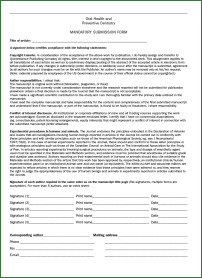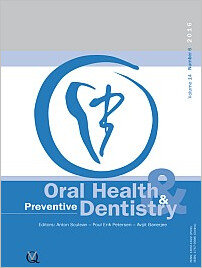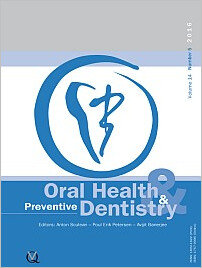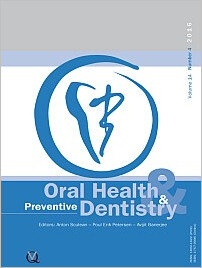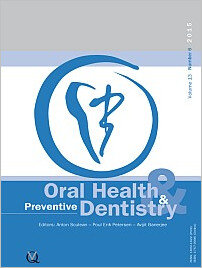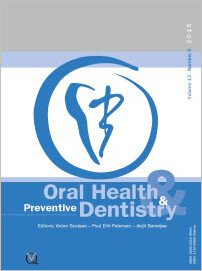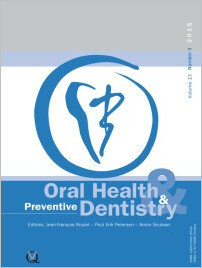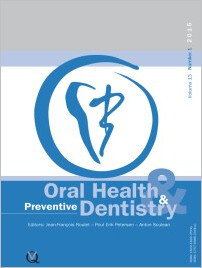DOI: 10.3290/j.ohpd.a37363, PubMed ID (PMID): 27957558Pages 483-484, Language: EnglishLevin, LiranDOI: 10.3290/j.ohpd.a37135, PubMed ID (PMID): 27957559Pages 485-491, Language: EnglishTurska-Szybka, Anna / Gozdowski, Dariusz / Mierzwińska-Nastalska, Elżbieta / Olczak-Kowalczyk, DorotaPurpose: To clinically evaluate the effectiveness of resin infiltration in conjunction with fluoride varnish treatment vs fluoride varnish treatment alone on facial smooth-surface caries lesions in deciduous teeth.
Materials and Methods: This randomised clinical trial was conducted in 419 children aged 18-71 months with at least two active smooth-surface caries lesions in deciduous teeth (ICDAS II score 2). Eighty-one participants met the inclusion criteria and were allocated to one of the two treatment groups: resin infiltration and fluoride varnish (RI+FV) (n = 41) and fluoride varnish only (FV) (n = 40). The prevalence of treated white spot lesions (WSL) was scored. Fluoride varnish was applied in both groups every 3 months for a year.
Results: The mean baseline age of children was 3.8 ± 1.3 years. The effectiveness of resin infiltration measured as the percentage of children who did not present any progression of the treated lesions amounted to 43.1%. After one year, 92.1% of the infiltrated lesions (RI+FV) and 70.6% of the FV lesions had not progressed (p 0.001).
Conclusion: Resin infiltration in conjunction with fluoride varnish treatment of early facial smooth-surface caries lesions in deciduous teeth is superior to fluoride varnish treatment alone for reducing lesion progression.
Keywords: early caries lesions, fluoride varnish, randomised clinical trial, resin infiltration
DOI: 10.3290/j.ohpd.a36520, PubMed ID (PMID): 27957560Pages 493-500, Language: EnglishChopra, Aditi / Thomas, Betsy S. / Mohan, Kishan / Sivaraman, KarthikPurpose: To evaluate the negative auditory and non-auditory effects developed immediately after using ultrasonic scalers and their potential role in the development of permanent hearing loss.
Materials and Methods: The auditory functions of 60 dental clinicians were evaluated with the pure tone audiometry test (PTA), tympanogram and the otoacoustic emission test (OAE) before and immediately after using ultrasonic scalers. The paired t-test was used to evaluate the difference in the pre- and post-exposure recordings for all three tests.
Results: There was a significant increase in the PTA and tympanogram test results, along with reduced OAE values immediately after using ultrasonic scalers. Hearing ability dropped by 63% to 66% immediately after using ultrasonic scalers. The maximum hearing disability was noted for low-frequency thresholds. The reduction was greater in the left than in the right ear.
Conclusions: Noise-emitting devices such as ultrasonic scalers produce significant immediate auditory and non-auditory changes. It is important that dentists recognise the initial signs of hearing damage and adopt appropriate measures while working to prevent the development of permanent hearing impairment in future.
Keywords: auditory damage, hearing, hearing loss, noise, ultrasonic scalers
DOI: 10.3290/j.ohpd.a36464, PubMed ID (PMID): 27351729Pages 501-508, Language: EnglishOliveira, Deise Cruz / Warren, John J. / Levy, Steven M. / Kolker, Justine / Qian, Fang / Carey, CliftonPurpose: Little is known about use or acceptance of minimally invasive dentistry (MID) in the USA, particularly in public health settings. The purpose of this study was to assess opinions concerning MID among dentists in public-health practices.
Materials and Methods: A cross-sectional study was conducted to assess the views of dentists in public-health practices concerning MID using an online survey instrument among National Network for Oral Health Access (NNOHA) and American Association of Community Dental Programs (AACDP) members. Specific questions focused on diagnostic and preventive techniques, and whether MID was considered to meet the standard of care in the US
Results: Overall, 86% believed that MID met the standard of care for primary teeth, and 77% did so for permanent teeth. The majority of respondents also agreed that fluoride varnish prevents caries and atraumatic restorative techniques (ART) are an effective caries treatment for children and adults. According to logistic regression results, dentists who had continuing education courses in MID and agreed that ART was an effective treatment for adults were more likely to report that MID met the standard of care for permanent teeth. Subjects who believed that fluoride varnish was effective as caries prevention for children were more likely to view MID as meeting the standard of care for primary teeth.
Conclusions: There appears to be a paradigm shift toward a MID philosophy, and most responding public health dentists believed that MID meets the standard of care for primary and permanent teeth in the US.
Keywords: dental caries, minimally invasive dentistry, preventive dentistry, public health dentistry
DOI: 10.3290/j.ohpd.a37136, PubMed ID (PMID): 27957561Pages 509-517, Language: EnglishKarimi-Shahanjarini, Akram / Makvandi, Zeinab / Faradmal, Javad / Bashirian, Saeid / Hazavehei, Mohammad M.Purpose: The present study sought to apply the expanded theory of planned behaviour (TPB) to the prediction of mothers' intention to brush their children's teeth and examine the mediating role of the variables of the TPB on the relationship between past behaviour and the intention.
Materials and Methods: This cross-sectional study was carried out among 211 mothers with children ages 2 to 5 years. Participants completed measures of the TPB (i.e. attitude, subjective norm, perceived control and intention) and past behaviour in relation to brushing. Regression analyses were conducted to explore the predictors of mothers' intention. Mediation was assessed using Preacher and Hayes' INDIRECT.SPSS macro.
Results: The TPB explained 25% of the variance in brushing intention, with attitude, subjective norms and perceived behavioural control making significant contributions. Past behaviour explained an additional 3% of the variance in intention. Analysis showed that TPB variables only partially mediate the effect of past behaviour on intention.
Conclusions: Our findings revealed that mothers' intention to brush their children's teeth is under the control of both past behaviour and psychological factors. Accordingly, interventions to improve children's toothbrushing should focus on the motivational (e.g. attitude) as well as the habitual determinants (e.g. environmental cues). However, given the low explanatory power of our model, it may be necessary to incorporate other psychological and environmental variables into an explanation of the mothers' intention to brush their children's teeth.
Keywords: brushing, children, oral health, past behaviour, theory of planned behaviour
DOI: 10.3290/j.ohpd.a37137, PubMed ID (PMID): 27957562Pages 519-528, Language: EnglishAlsumait, Aishah / ElSalhy, Mohamed / Almunezaa, Eman / Ariga, Jitendra / Al-Mutawa, Sabiha / Amin, MaryamPurpose: To measure oral health (OH) knowledge, attitude and practices (KAP) of primary school teachers and to evaluate the relationship between these measures and oral health-related quality of life (OHRQoL).
Materials and Methods: A total of 1013 school teachers from all regions of Kuwait were randomly selected in this cross-sectional study. A questionnaire on demographics, knowledge, attitude, practices and OHRQoL was used. Frequencies and means (SD) were used for data description. Correlations between KAP and OHRQoL were evaluated using Pearson's correlation coefficient. Associations between practice-specific knowledge and its corresponding practice as well as knowledge and practices and OHRQoL were determined using the chi-squared test.
Results: About 71% of the participants were females, 57% were 30-50 years old, and 75% had a college education. The mean (95%CI) knowledge score was 60.2% (57.2-62.0), ranging from 15.4% to 93%. The well-known OH facts were the importance of brushing twice a day with fluoridated toothpaste, the cariogenic effect of sticky, sugary foods and snacks, as well as the damage that soft drinks can cause to teeth. The least known facts were replacement frequency of toothbrush, parent's supervision of children's brushing and the benefit of regular flossing. Weak but significant correlations were found between KAP components and OHRQoL (p 0.05). All practice-specific OH knowledge was significantly associated with its practice, except brushing and flossing (p > 0.05). Self-esteem was the mostly frequently affected OHRQoL construct by improper OH practices.
Conclusion: Oral health knowledge by itself is not enough to change improper OH practices. Developing behaviourchanging interventions based on OHRQoL outcomes may be beneficial.
Keywords: behavioural science, dental education, dental health perceptions, oral hygiene, quality of life
DOI: 10.3290/j.ohpd.a37138, PubMed ID (PMID): 27957563Pages 529-534, Language: EnglishDjemal, Serpil / Rumjon, Adam / Macdougall, Iain C. / Singh, Parmjit / Warnakulasuriya, SamanPurpose: To compare the oral health status of renal patients attending a dialysis unit at a London teaching hospital with an age- and sex-matched sample from the Adult Dental Health Survey UK (ADHS) 2009.
Materials and Methods: Questions adapted from the ADHS 2009 national survey were used to interview renal dialysis patients about their oral health, oral hygiene and dental visits. Any significant differences between the two groups were statistically analysed using the chi-squared (χ2) test.
Results: Two hundred renal dialysis patients participated. More renal dialysis patients were edentulous (p 0.0001) and those who were dentate had fewer teeth (p 0.0001) compared to the ADHS 2009 participants. Although 12% of the renal dialysis patients had difficulty in finding a dentist, 77% were linked to a dental practice, but fewer reported that they had previously been shown how to brush their teeth compared to the dentate ADHS group (p 0.0001). The frequency of brushing (twice daily) was similar in the dialysis and ADHS groups.
Conclusion: Awareness for good oral health needs to be raised in this group of medically compromised patients regularly attending a hospital unit. The responsibility for achieving this goal needs to be shared by both dialysis teams and oral health care professionals. We suggest an 'oral health toolkit' be made available in dialysis units for both professionals and patients.
Keywords: Adult Dental Health Survey, dental attendance, oral health status, renal dialysis
DOI: 10.3290/j.ohpd.a37139, PubMed ID (PMID): 27957564Pages 535-545, Language: EnglishArpalahti, Irma / Järvinen, Mirkka / Kommonen, Hanna-Mari / Tolvanen, Mimmi / Pienihäkkinen, KaisuPurpose: To study new programmes in health promotion of 6- to 36-month-old children included in the public dental service (PDS) of Vantaa and compare them with the previously used programme by assessing parents' opinions on the oral health counselling and their readiness to make changes in oral health habits. An additional aim was to study parents' readiness to change their child's health habits in relation to the child's MS colonisation, health habits and parents' education.
Materials and Methods: The subjects consisted of the parents of first-born children examined at age two (n = 647). The link to the study was e-mailed to the parents (n = 586) after their child's two-year visit. The dental professionals were trained to do plaque testing, observe dental decay and control the progression of caries lesions, utilise the oral health counselling programmes and deliver client-centered counselling. Data were statistically analysed using Pearson's Chi-Square and logistic regression.
Results: The response rate was 68%. In the opinion of 91% of the respondents, the information received was at least somewhat useful. The respondents in the new programmes were more likely to report at least intending to change their own health habits (p = 0.032). There was, however, no programme-related difference in readiness for change their child's health habits. Respondents who made/intend to make changes reported a lower level of education and their children were more likely to have had positive MS scores compared to children whose parents reported having made no changes.
Conclusions: It may be possible to promote beneficial habits by delivering oral health counselling to parents, who would thus serve as better role models for their children. The findings indicate that the changes occurred in the families who needed it most.
Keywords: children, counselling, family-based, health habits, oral health promotion
DOI: 10.3290/j.ohpd.a36465, PubMed ID (PMID): 27351730Pages 547-553, Language: EnglishVieira, Gustavo Henrique Apolinario / Nogueira, Marcia Bessa / Gaio, Eduardo Jose / Rosing, Cassiano Kuchenbecker / Santiago, Sergio Lima / Rego, Rodrigo OtavioPurpose: To compare the effect of toothbrushing abrasion with hydrated silica-based whitening and regular toothpastes on root dentin using contact profilometry.
Materials and Methods: Ninety dentin specimens (4 x 4 x 2 mm) were randomly divided into five experimental groups (n = 18) according to the toothpaste: three whitening (W1, W2 and W3) and two regular toothpastes (R1 and R2) produced by two different manufacturers. Using a brushing machine, each specimen was brushed with a constant load of 300 g for 2500 cycles (4.5 cycles/s). The toothpastes were diluted at a ratio of 1:3 w/w (dentifrice:distilled water). The brush diamond tip of the profilometer moved at a constant speed of 0.05 mm/s with a force of 0.7 mN.
Results: The average value of brushing abrasion in μm (mean ± SD) was obtained from five consecutive measurements of each specimen: W1 = 8.86 ± 1.58, W2 = 7.59 ± 1.04, W3 = 8.27 ± 2.39, R1 = 2.89 ± 1.05 and R2= 2.94 ± 1.29. There was a significant difference between groups (ANOVA, p0.0001). Post-hoc Tukey's test for multiple comparisons showed differences between all the whitening and regular toothpastes, but not among the whitening nor among the regular toothpastes.
Conclusion: The whitening toothpastes tested can cause more dentin abrasion than the regular ones.
Keywords: bleaching agents, dentifrice, tooth abrasion, toothbrushing
DOI: 10.3290/j.ohpd.a37140, PubMed ID (PMID): 27957565Pages 555-561, Language: EnglishZhang, Wen / McGrath, Colman / Lo, Edward C. M.Purpose: The purpose of this clinical research was to analyze the effectiveness of DIAGNOdent in detecting root caries without dental scaling.
Materials and Methods: The status of 750 exposed, unfilled root surfaces was assessed by visual-tactile examination and DIAGNOdent before and after root scaling. The sensitivity and specificity of different cut-off DIAGNOdent values in diagnosing root caries with reference to visual-tactile criteria were evaluated on those root surfaces without visible plaque/calculus. The DIAGNOdent values from sound and carious root surfaces were compared using the nonparametric Mann-Whitney U-test. The level of statistical significance was set at 0.05.
Results: On root surfaces without plaque/calculus, significantly different (p 0.05) DIAGNOdent readings were obtained from sound root surfaces (12.2 ± 11.1), active carious root surfaces (37.6 ± 31.7) and inactive carious root surfaces (20.9 ± 10.5) before scaling. On root surfaces with visible plaque, DIAGNOdent readings obtained from active carious root surfaces (29.6 ± 20.8) and inactive carious root surfaces (27.0 ± 7.2) were not statistically significantly different (p > 0.05). Furthermore, on root surfaces with visible calculus, all DIAGNOdent readings obtained from sound root surfaces were > 50, which might be misinterpreted as carious. After scaling, the DIAGNOdent readings obtained from sound root surfaces (8.1 ± 11.3), active carious root surfaces (37.9 ± 31.9) and inactive carious root surfaces (24.9 ± 11.5) presented significant differences (p 0.05). A cut-off value between 10 and 15 yielded the highest combined sensitivity and specificity in detecting root caries on root surfaces without visible plaque/calculus before scaling, but the combined sensitivity and specificity are both around 70%.
Conclusion: These findings suggest that on exposed, unfilled root surfaces without visible plaque/calculus, DIAGNOdent can be used as an adjunct to the visual-tactile criteria in detecting root-surface status without pre-treatment by dental scaling.
Keywords: caries detection, dental scaling, DIAGNOdent, laser fluorescence, root caries
DOI: 10.3290/j.ohpd.a37141, PubMed ID (PMID): 27957566Pages 563-569, Language: EnglishGuizar, Juan Manuel / Muñoz, Nathalie / Amador, Norma / Garcia, GabrielaPurpose: To determine the association between types of food consumed, nutritional status (BMI) and caries in schoolchildren.
Material and Methods: A cross-sectional study was performed with 224 schoolchildren 6 to 12 years of age. DMFT/ dmft indices, level of oral hygiene, nutritional status as quantified by BMI and types of food consumed were determined in all participants. Data were analysed using multiple linear regression with significance set at p 0.05.
Results: Caries prevalence was 36%. In the multiple linear regression analysis adjusted for BMI, variables related to a higher number of caries were younger age and lower intake of vitamin D, calcium and fiber, with higher consumption of phosphorous and carbohydrates (R2 = 0.30; p 0.0001 for the model). Sweetened softdrinks and chewy candy were risk factors for higher caries prevalence, while consuming milk and carrots were protectors.
Conclusion: Caries in schoolchildren is highly prevalent in this community and is related to younger age and lower intake of vitamin D, calcium and fiber, but a higher consumption of phosphorous and carbohydrates. No relationship was found between caries and nutritional status.
Keywords: caries, carrots, nutritional status, schoolchildren, softdrinks, vitamin D








